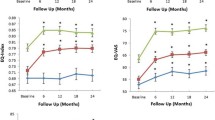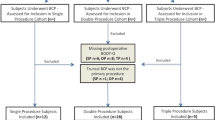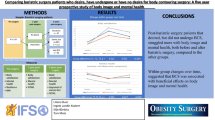Abstract
Background
The number of surgical procedures performed for obesity and massive weight loss (MWL) is increasing. The authors set out to quantify the health state utility assessment of living with MWL that can occur after such procedures.
Methods
Utility assessments using the visual analog scale (VAS), time trade-off (TTO), and standard gamble (SG) were used to obtain utilities for MWL, monocular blindness, and binocular blindness from a sample of the general population and medical students.
Results
All the measures for MWL of the 100 volunteers (VAS, 0.79 ± 0.13; TTO, 0.89 ± 0.12; SG, 0.89 ± 0.15) were significantly different (p < 0.005) from the corresponding measures for monocular blindness (0.63 ± 0.18, 0.84 ± 0.17, and 0.86 ± 0.16, respectively) and binocular blindness (0.31 ± 0.17, 0.63 ± 0.28, and 0.66 ± 0.27, respectively) except for the SG utility measure comparing monocular blindness with MWL. Age was inversely proportional to the TTO utility scores for MWL (p < 0.05). Caucasian race and medical education were independent predictors of SG utility scores (p < 0.05).
Conclusion
In a sample of the general population and medical students, SG utility assessments for MWL were comparable with those for monocular blindness. Utility assessment of living with MWL varied with race (VAS and SG) and education (SG). The sample population, if faced with MWL, would consent to undergo a procedure such as body contouring with an 11% chance of death and be willing to trade 4 years of their life.


Similar content being viewed by others
References
Read JL, Quinn RJ, Berwick DM, Fineberg HV, Weinstein MC (1984) Preferences for health outcomes: comparison of assessment methods. Med Decis Making 4:315–329
Torrance GW, Feeny D (1989) Utilities and quality-adjusted life years. Int J Technol Assess Health Care 5:559–575
Chang WT, Collins ED, Kerrigan CL (2001) An Internet-based utility assessment of breast hypertrophy. Plast Reconstr Surg 108:370–377
Kerrigan CL, Collins ED, Kneeland TS et al (2000) Measuring health state preferences in women with breast hypertrophy. Plast Reconstr Surg 106:280–288
van Osch SM, Stiggelbout AM (2008) The construction of standard gamble utilities. Health Econ 17:31–40
Torrance GW (1986) Measurement of health state utilities for economic appraisal. J Health Econ 5:1–30
Stevens KJ, McCabe CJ, Brazier JE (2006) Mapping between visual analogue scale and standard gamble data: results from the UK Health Utilities Index 2 valuation survey. Health Econ 15:527–533
Sinno HH, Thibaudeau S, Duggal A, Lessard L (2010) Utility scores for facial disfigurement requiring facial transplantation [outcomes article]. Plast Reconstr Surg 126(2):443–449
Nord E (1991) EuroQol: health-related quality-of-life measurement: valuations of health states by the general public in Norway. Health Policy 18:25–36
Nease RF Jr, Tsai R, Hynes LM, Littenberg B (1996) Automated utility assessment of global health. Qual Life Res 5:175–182
Lenert LA, Morss S, Goldstein MK et al (1997) Measurement of the validity of utility elicitations performed by computerized interview. Med Care 35:915–920
Picot J, Jones J, Colquitt JL, Gospodarevskaya E, Loveman E, Baxter L, Clegg AJ (2009) The clinical effectiveness and cost-effectiveness of bariatric (weight loss) surgery for obesity: a systematic review and economic evaluation. Health Technol Assess 13(41):1–190, 215–357, iii–iv
Smith KJ, Roberts MS (2005) Quality-of-life utility values for erectile function and sildenafil treatment. Clin Drug Investig 25:99–105
Weinstein MC, Siegel JE, Gold MR, Kamlet MS, Russell LB (1996) Recommendations of the panel on cost effectiveness in health and medicine. JAMA 276:1253
Torrance GW (1982) Preferences for health states: a review of measurement methods. Mead Johnson Symp Perinat Dev Med 20:37–45
Torrence GW (1997) Preferences of health outcomes and cost-utility analysis. Am J Manag Care 3:S8–S20
Llewellyn-Thomas H, Sutherland HJ, Tibshirani R et al (1984) Describing health states: methodologic issues in obtaining values for health states. Med Care 22:543–552
Acknowledgments
There was no external financial support for this study.
Conflict of interest
None of the authors have a financial interest in any of the products, devices, drugs or procedures mentioned in this manuscript.
Author information
Authors and Affiliations
Corresponding author
Rights and permissions
About this article
Cite this article
Sinno, H., Thibaudeau, S., Tahiri, Y. et al. Utility Assessment of Body Contouring After Massive Weight Loss. Aesth Plast Surg 35, 724–730 (2011). https://doi.org/10.1007/s00266-011-9676-1
Received:
Accepted:
Published:
Issue Date:
DOI: https://doi.org/10.1007/s00266-011-9676-1




